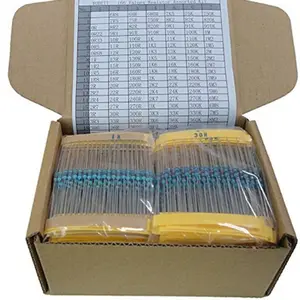
All categories
Featured selections
Trade Assurance
Buyer Central
Help Center
Get the app
Become a supplier

(4727 products available)









































Imperative Electronic parts manufacturers make diverse types of 600 ohm resistors, according to the specifications and requirements of particular applications. Thus, understanding these types is quite important. Here are the common types of 600 ohm resistors available:
These are high-powered resistors made of wire and a ceramic body that can withstand extreme heat, making them ideal for high-power applications like industrial machinery.
These are produced by depositing a metal film on a ceramic substrate and offer high precision and low temperature coefficients, often used in audio equipment and instrumentation for reliable performance.
Over the cylindrical core of ceramic or plastic, wire-wound resistors are made. Because of their design, they can be used in higher-power applications than thin film or thick film resistors.
These resistors are made from a ceramic substrate coated with a paste made of metal particles and insulating substances. These resistors are typically used in general-purpose applications where moderate precision is required and can handle moderate power levels.
These can be adjusted to different resistance values, useful in applications where the resistance needs to be changed, like volume controls in audio equipment. Thus, a 600 ohm variable resistor is common in so many electronic gadgets, and its resistance can be adjusted to fit particular requirements.
600 ohm resistors are very important in the professional audio and telecommunications circuits, including the vintage one. Due to their excellence in controlling signal loss over long distances, they are exceptionally suitable for matching cable and equipment impedances.
Moreover, meters, oscilloscopes, and other yard tools use restraining networks that contain 600-ohm deviators, which helps create precise readings and signal processing.
600 ohm resistors are regularly found in public address systems, speaker systems, and microphones. There, such helps restrict audio signals, ensuring clear and distortion-free sound transmission. This makes them pivotal for audio fidelity in large venues and professional recording studios.
Various electronic equipment, such as signal processing devices, audio equipment, and measuring instruments, uses 600-ohm resistors. They are relevant in those settings where there is a need for high accuracy, audio signal integrity, and better performance of the equipment.
They are additionally applied in their electronic systems, such as car radio, navigation, and communication systems; 600 ohm resistors help maintain signal consistency and avoid interference. Therefore, providing clear and consistent signals in the automotive context is important for overall system performance.
As we delve deeper into the commercial aspects of the 600-ohm resistor, we can already appreciate its relevance in revenue-generating activities. Here's how they come to play:
In commercial audio equipment, including speakers, microphones, and mixing boards, 600 ohm resistors remain a core feature. No wonder! They allow the equipment to transmit audio signals effectively. Hence, they're crucial in helping businesses like recording studios, concert venues, and broadcasters achieve quality sound since these companies rely on the clarity and reliability of audio performance.
In telecommunication systems, such as phone networks and data transmission systems, 600 ohm resistors stabilize the signals. Basically, they make sure that signal integrity is kept over great distances. Businesses working in telecommunications infrastructure and network services depend on those resistors for the performance and efficiency of their communication systems.
Furthermore, 600 ohm audio resistors can be found in commercial-level medical devices such as patient monitoring systems, diagnostic equipment, and medical imaging systems. Here, the resistors ensure the accurate functioning of highly sensitive electrical systems. In the medical field, where precision and reliability are crucial, healthcare services, such as hospitals and clinics, rely on those resistors for their diagnostic and monitoring equipment. They further verify the quality and dependability of premium medical services.
Commercial electronics use 600 ohm resistors in their signal processing and control systems. In industrial settings, these resistors help manage the performance and efficiency of machinery and equipment. Businesses in manufacturing, automation, and heavy industry rely on those resistors to keep their equipment functioning efficiently.
The determination of the perfect 600-ohm metal oxide resistor is still more complex if one considers several factors. Following are these essential factors:
When the resistor's temperature changes, its resistance value may fluctuate. A lower temperature coefficient means less variation, which is important in precision applications.
This indicates how much power the resistor can handle without failing. Selecting one with an appropriate power rating for the circuit is important. Operating a resistor above its power rating can lead to overheating and destruction.
This is the acceptable deviation from the resistor's nominal value. Lower tolerance resistors provide more precise resistance values; thus, they're fit for applications where precision is critical.
The two common constructions are wirewound and film. Wirewound resistors are ideal for high-precision applications. In contrast, film resistors are typically used for general purposes due to their lower cost and size.
600 ohm resistors are available in variable and non-variable types. Variable resistors allow for adjustable resistance values, thus making them vital in applications that require adaptability. Conversely, fixed resistors provide a consistent resistance value suitable for most standard applications.
A: In an electronic circuit, the 600-ohm resistor helps to limit the current and protect sensitive components from being overwhelmed by excessive current, which can cause damage.
There are three main factors to consider when selecting a resistor for electronic circuits. They are the power rating, tolerance, and temperature coefficient.
In an audio system, the resistor controls the amount of signal that passes through, which will help in balancing and clarifying the sound, hence preventing signal distortion.
Variable resistors allow users to change resistance, making them perfect for gadgets like dimmers and volume controls, where adjustment is needed.
Exceeding a resistor's power rating can cause it to overheat. This will further lead to failure, possible immediate circuit destruction, and damage to adjacent components.